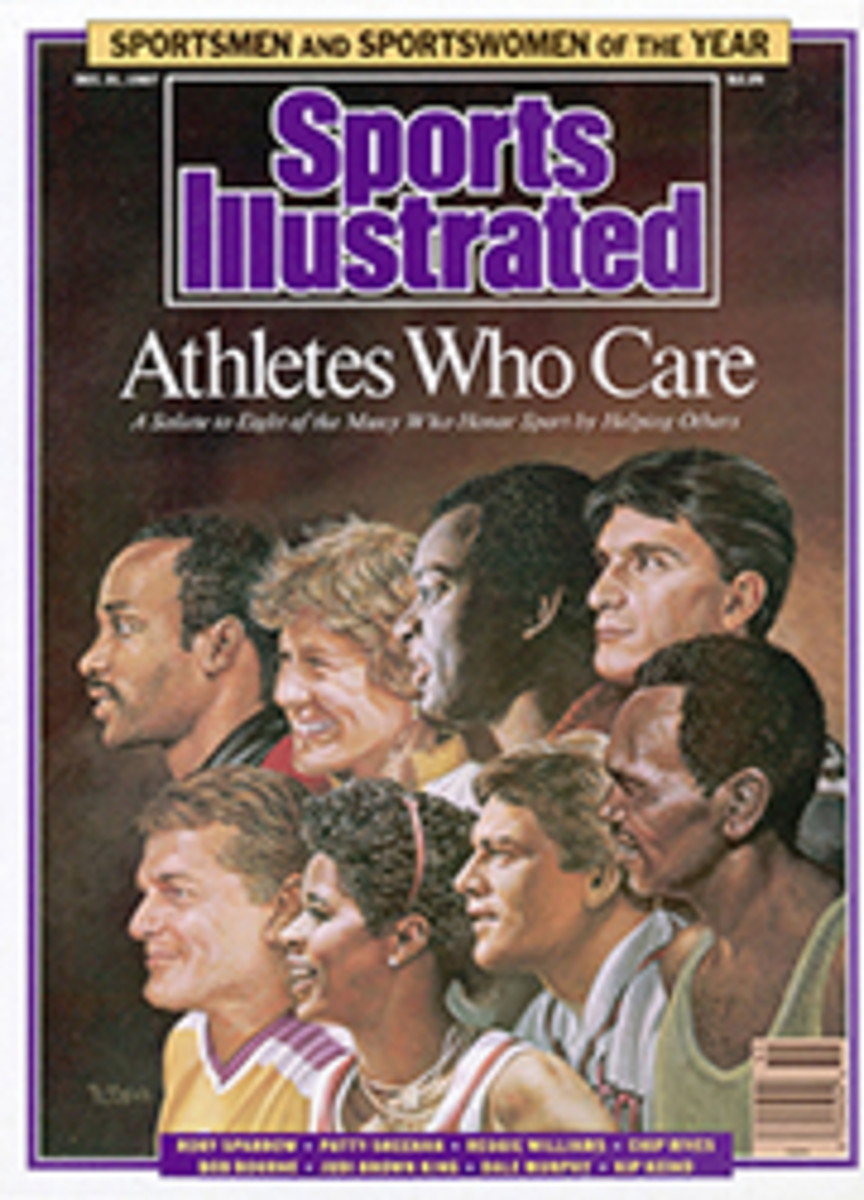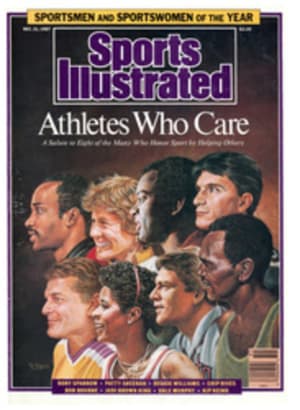
'A Little Lower than the Angels'
So nigh is grandeur to our dust, So near is God to man, When Duty whispers low, Thou must, The youth replies, I can.
—RALPH WALDO EMERSON
Dedicated, with thanks to the poet, who surely would approve, to: Dale Murphy. Judi Brown King. Chip Rives. Rory Sparrow. Kip Keino. Bob Bourne. Patty Sheehan. Reggie Williams.
There is an old cynical expression that once a man becomes a bishop, he never again eats a bad meal or hears the truth, and if that's an exaggeration, so also is it a fact that all hyperbole flowers from a seed of truth. If, indeed, there can be that sort of effect even on a shepherd of the church, a mature man, wholly formed and presumably virtuous, imagine how easy it is to turn the heads of men-children and women-children who play games for great gobs of money and buckets of acclaim.
Imagine, if you will, being young and rich and famous and possessing a body that is better than almost anyone else's and always does your bidding. In those circumstances, you might well be, as so many modern athletes are, vainglorious, thoughtless and indulgent, even avaricious. These unattractive qualities have become so commonplace that our perception of the athlete has changed. Not very long ago, the beau ideal was a champion who was in equal measure athlete and sportsman, a hero who considered victory without integrity to be unworthy of the reward. But today: Sportsman? Sportsmanship? What a quaint notion. Sportsmanship has, in fact, been superseded by a relatively new term, gamesmanship, which is very nearly the antonym for sportsmanship—infamy to its fame, greed to its grace.
Granted, this is hardly an age when honor is a frequent flier on any of mankind's routes. But the earliest editors of this magazine were not, we can be sure, altogether naive or out-of-touch when, in 1954, they got the idea of honoring a Sportsman of the Year. By then, the Georgia Peach had been celebrated for filing his spikes, All-America boys had confessed to fixing the varsity's games and Leo Durocher had delivered his assessment of where nice guys might expect to end up. Yet nobody blinked when the award was established. In 1954 arenas and stadiums still were widely peopled by sportsmen. Imagine that.
Today it's rare even to hear the term in its pure context, except when the Sportsman of the Year issue comes out, dutifully, like Christmas spirit, each December. But for the rest of the year, a sportsman is, in common usage, usually one of two things: 1) someone of inherited wealth who invests in racing yachts or thoroughbreds or 2) someone who shoots animals. The sense of sportsman that was meant in 1954 seems, in 1987, to be heading toward extinction.
But, thankfully, notwithstanding the fact that many athletes today are self-absorbed reprobates, there remain a number who vividly defy the negative image of their breed. These stalwarts are, instead, generous and caring, charitable and devoted, responsible; they are dear hearts, noble men and women; they are, at the last, good sports.
And so, this December, as for the 34th time we salute a Sportsman of the Year—or a Sportswoman, or Sportsfolk—we have elected, more than ever, to honor the whole athlete, not simply that fabulously facile part that scores goals and wins games. On the pedestal stand together: Mr. Murphy from baseball; Ms. King from track; Mr. Rives from college football; Mr. Sparrow from basketball; Mr. Keino from track; Mr. Bourne from hockey; Ms. Sheehan from golf; and Mr. Williams from football.
In one sense these men and women are representative, vicars of all athletes who give of themselves unto others. But, as you will read on the following pages, they are not merely symbolic; they are very much flesh and blood, and this: They are the worthiest.
Still, it's always difficult to select a Sportsman of the Year, to pick one champion over the others. In the present exercise, the business of choosing is even more subtle, more perplexing. How, for example, can we overlook so many deserving individuals?
There is Pablo Morales, the Olympic gold medal-winning swimmer, who graduated from Stanford last June as the winner of that university's highest award for campus and community involvement, which in his case included directing a program called Volunteers for Youth. And Nick Santagata, the New York jockey who seems to commit himself to every good cause that touches the track or his home, and who is also known as a soft touch for every stable boy or hot walker who ever tapped out on a sure triple. And Pam Shriver, the No. 4-ranked female tennis player in the world, who organizes (and plays in) her own tournament for the benefit of cystic fibrosis research and sits on her prep-school board of trustees. And Wayne Gretzky, hockey's best, Sportsman of the Year for 1982, who gives time to boost the causes of the blind, the mentally retarded and juvenile diabetics. Or Don Baylor, Ivan Lendl, Tatu, Rick Sutcliffe, Nolan Cromwell, Fernando Valenzuela, Chi Chi Rodriguez. Any of them, for his good works, could have been chosen.
Beyond the more obvious candidates, we also recognize that the most meritorious may be athletes we have never heard of—some terrific young man who hit .240 in Double A or some wonderful young woman who plays on a Division III field hockey squad. There are a lot of people in sports whom we simply haven't met, but who can be properly located, as the psalmist sang, only "a little lower than the angels." So, if you know one of them, thank him for us, for his good deeds, and tell her that we saved a space for her, and all those like her, to squeeze in.
There is room for many people of many interests in this eclectic group. But while our honorees of 1987 espouse varied causes, one thread seems to run throughout—a devotion to children. Just as naturally, children look up to athletes. This distresses many adult know-it-alls who think that the future of the republic is threatened because American tykes admire linebackers and power forwards instead of people they damn well should be admiring—proper sorts, such as statesmen, clergymen and philosophers.
Nonsense. The kid who looks up to a politician or a preacher is the rare exception. Most children idolize athletes. In fact, athletes (and other entertainers) are, as we shall see, more important to children today than ever before. Unfortunately, many athletes are uncomfortable with this reality and try to evade what it means. It's their contention that as long as they go out and play ball, nothing else is required of them. This is fallacious on a number of counts. First, star athletes are part of a business that is in the public eye. Scrutiny goes with the whole luxurious territory. Second, athletes are rewarded commensurate with their fame, not their intrinsic talent, and they should be obliged to pay back in that same popular currency. And finally, as glib as this may sound nowadays, it still obtains: To whom much is given, much is expected. It's simple. Athletes can make a difference in children's lives, and it matters little that these heroes are relatively inconsequential to the world because they're "just" in sports. On the contrary, if children see that some athletes are models for good, then they may be more inclined to believe that the "real" leaders—those at the helms of state and church and business—are likewise to be trusted and admired.
Moreover, the position that athletes fill in young lives—in their upbringing—is bound only to enlarge. As a nation, we have been melding. We've moved hither and yon, we gobble the same franchise food, nod at the same anchormen. For so long we were a confederation of ethnic groups, of neighborhoods and extended families, but now most of the nation shares so much—not least, national sports—that the Americanization of Americans is nearly complete. "What do you know of life?" Sarah, the Salvation Army lady, asks Sky Masterson in Guys and Dolls. "Only a little bit," he replies. "Around the edges." There are not many edges left anymore in America.
Another result of this distillation process is that we have lost much of what may be described as the cultural middle management of the nation. As ethnic identity has become less distinct, as neighborhoods have scattered and families stretched beyond the supply lines, the precinct captain and the high school principal and the great-aunts and uncles, some of the characters who once formed the superstructure of the child's community, have tumbled off the edgeless ends.
Others had to replace them and others did: the celebrity oligarchy. It seems to me that a kind of U.S. royal court has grown up in which only fame and face count. Members of the oligarchy all appear of the same value, regardless of their profession. Lee Iacocca, Magic Johnson, Mac Tonight and Jimmy Swaggart are down at the Gulf station together, kicking tires. The quality of a person's accomplishment fades behind the smile so that senators, scientists and shortstops all appear equal in their achievement. Because children are more familiar with sports stars, it's no wonder that athletes will exert an even more disproportionate influence upon our young people.
Bill Russell was perhaps the first star athlete to make a philosophical point of not signing autographs, explaining that no mere athlete should be lionized, that a child should esteem his own father instead. It's a lofty sentiment, but impractical. Fathers (and mothers) loom too close, too human, too quotidian ever to merit their own child's hero worship. Athletes and other entertainers will always be a bigger deal.
Sports stars who are decent and giving do matter. They may be "just" in sports, but they make an impact on young lives and, therefore, on society. We are proud to honor here the eight Sportsmen and Sportswomen of 1987, athletes who best practice the ideals of sportsmanship away from the arena. As always, it is for parents to raise children, but their task is made easier because some athletes will stoop and help other people—and with that, uplift us all.
ILLUSTRATION
RICHARD HESS
ILLUSTRATION
MARK HESS
DALE MURPHY
ILLUSTRATION
MARK HESS
JUDI BROWN KING
ILLUSTRATION
MARK HESS
CHIP RIVES
ILLUSTRATION
MARK HESS
RORY SPARROW
ILLUSTRATION
MARK HESS
KIP KEINO
ILLUSTRATION
MARK HESS
BOB BOURNE
ILLUSTRATION
MARK HESS
PATTY SHEEHAN
ILLUSTRATION
MARK HESS
REGGIE WILLIAMS

